Butterfly diversity in Lateritic biotope of Kavvayi River Basin, Kerala, India
K. A Sreejith 1 * , T. S. Prasad 1 , Dhaneesh Bhaskar1 , M. P. Prejith1 , K. P. Rajkumar1 and C. J. Alex1
Corresponding author Email: sreejith@kfri.res.in
DOI: http://dx.doi.org/10.12944/CWE.12.1.16
A study on butterfly diversity of lateritic biotopes of Kavvayi River Basin was conducted during February 2013 to January 2015. The study area represents diverse habitats that include sacred groves, laterite hills, riparian ecosystem, and kanams. A total of 140 species butterflies were recorded from the study area, among which the highest number of butterfly species were from the family Nymphalidae (48 species), followed by Hesperiidae (32 species), Lycaenidae (27 species), Papilionidae and Pieridae with 16 species each and 1 from the family Riodinidae. The present study revealed the faunal richness of the unique ecosystems and microhabitats in lateritic biotopes in terms of butterfly diversity. The study also highlights conservation significance of the area which is under severe human pressure including mining, habitat fragmentation and change in the land-use system.
Copy the following to cite this article:
Bhaskar D, Prejith M. P, Rajkumar K. P, Alex C. J, Prasad T. S, Sreejith K. A. Butterfly diversity in Lateritic biotope of Kavvayi River Basin, Kerala, India. Curr World Environ 2017;12(1). DOI:http://dx.doi.org/10.12944/CWE.12.1.16
Copy the following to cite this URL:
Bhaskar D, Prejith M. P, Rajkumar K. P, Alex C. J, Prasad T. S, Sreejith K. A. Butterfly diversity in Lateritic biotope of Kavvayi River Basin, Kerala, India. Curr World Environ 2017;12(1). Available from: http://www.cwejournal.org/?p=16936
Download article (pdf) Citation Manager Publish History
Select type of program for download
| Endnote EndNote format (Mac & Win) | |
| Reference Manager Ris format (Win only) | |
| Procite Ris format (Win only) | |
| Medlars Format | |
| RefWorks Format RefWorks format (Mac & Win) | |
| BibTex Format BibTex format (Mac & Win) |
Article Publishing History
| Received: | 2017-03-04 |
|---|---|
| Accepted: | 2017-04-11 |
Introduction
The midland exposed laterite biotope associated with diverse ecosystems and microhabitats represents the most imposing and extremely threatened topographical floristic and faunistic features in the northern part of Kerala. Lateritic hills of the study area are unique with high microhabitat diversity and associated rich floral components.1 The diversity of plants, habitats, topography and climates influence distribution, diversity and abundance of butterflies2,3 and they are good biological indicators of habitat quality as well as general environmental health.4,5,6,7 Butterflies play a major role in the ecosystem as they interact with the environment as pollinators, seed dispersers, herbivores, predators and prey.8,9 Out of the 334 reported butterfly species of Western Ghats, 316 species of butterflies were recorded from Kerala.10 As per the review of literature, a large number of studies on diversity and distribution of butterflies were done in the protected areas of Kerala includes; Mathew & Rahmathulla11 who reported 100 species from Silent Valley National Park, Sudheendrakumar12 reported of 124 species from Parambikulam Wildlife Sanctuary, Shamsudheen and Mathew13 reported 73 species Shendurney Wildlife Sanctuary, Mathew14 reported 71 species from Peechi - Vazhani Wildlife Sanctuary, Mathew15 reported 53 species from Neyyar Wildlife Sanctuary. Other than protected areas, human dominated non-protected natural habitats like sacred groves, home gardens, and countryside city gardens are also important in terms of butterfly diversity9,17 as Kunte18 recorded 104 butterfly species from Pune city along with the human impact gradient, and recently Gaude17 reported 33 species of butterflies from four selected sacred groves of Goa. As far as Kerala is concerned, Aneesh19 reported 139 species of butterflies from Kerala Agricultural University Campus, Prasad20 recorded 52 species from Kerala University campus. There is very little information available on the ecology and biodiversity of laterite hills in which Palot and Radhakrishnan21 reported 111 species of butterflies from madayippara. The current study focused on butterfly diversity of Midland laterite biotope of Kavvayi river basin, North Kerala. This landscape includes lateritic hills, sacred groves, mangroves, riparian vegetation and locally conserved vegetations such as kaanam. As studies revealed the distribution patterns of many of the organisms that are currently of the greatest international conservation concern don’t coincide with broader diversity patterns like protected areas, parks and sanctuaries.22,23, 24,25 Hence diversity assessment in non-protected areas such as laterite hills, Kanams and sacred grooves are also significant.
Study Area
The mid land laterite hills of Kavvayi river basin is located between 120 05’ to 120 15’ North latitude and 750 05’ to 750 20’ East longitude (Fig 1). It spread over an area of 164.76 km2 covering 14 villages and spreads over nine local bodies in the districts of Kannur and Kasargod.
The selected ecosystems include Lateritic hills (IT Park, Ariyittapara and Madayippara); Sacred Groves (Edayilakkadu Kavu, Mappittassery Kavu and Chamakkavu) and ‘Kaanam’ (Vattapoyil Kaanam and Vannathikaanam) which are distributed in Lateritic biotopes of Kannur and Kasargod Districts (Fig 1).
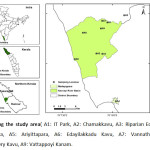 |
|
Materials and Methods
Butterflies were observed for a period two year from February 2013 to January 2015. The observations were made randomly from 0800 hr to 1100 hr, which is the peak time of butterfly activity and also they were observed from 1530 hr to 1730 hr. Butterflies were identified directly from the field and in difficult cases, they were photographed and identified using the field guides.26,27 Taxonomy and nomenclature have been updated after.28 Butterflies observed were categorized into three groups based on their occurrence in selected study areas. Accordingly, those observed in 7-9 locations were listed as very common (VC), 4-6 as common (C), 1-3as rare (R).Data were further analysed by cluster analysis based on squared Euclidean distance using SPSS 20 version.
Results and Discussion
The study reports a total of 141 species butterflies from lateritic biotopes of Kavvayi river basin. Among which the highest number of butterfly species were from the family Nymphalidae (48 species) with three Western Ghat endemic butterflies (Cirrochroa thais, Kallima horsfieldii and Mycalesis junonia) followed by Hesperiidae (32 species) with one Western Ghat endemic (Oriens concinna), Lycaenidae (27 species) with one Western Ghat endemic (Curetis siva), Papilionidae (16 species) with two Western Ghat endemics (Papilio dravidarum, Papilio liomedon), Pieridae(16 species)with one Western Ghat endemic (Pareronia ceylonica), and one butterfly from the family Riodinidae. Family wise distribution of butterflies is represented in the Fig. 2. The study area hosts eight butterflies which are protected under various schedules of the Indian Wildlife (Protection) Act, 1972 (Table 1).
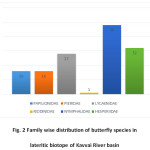 |
|
Butterfly diversity in different laterite ecosystems is varied in terms of a number of species ( Fig. 3).
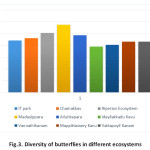 |
|
The distribution of a butterfly species in a definite area is mainly based on the diversity of plants, habitats, topography and climates.2 Other than the environmental conditions diversity of butterflies in sacred groves is also influenced by the presence of surrounded human settlements and home gardens. The presence of home gardens has a positive influence in Mappittassery and Chamakkavu in terms of a number of butterfly species, whereas in Edayilakkadu Kavu the diversity is comparatively lesser than the other two. The newly proposed IT park area is having a total of 88 species of butterfly among which Pachliopta hector, Papilio clytia, Hypolimnas misippus and Castalius rosimon are protected species under the Schedule I and Appias lyncida is protected species under Schedule II of Indian Wildlife Protection Act of 1972. Madayippara and Ariyittapara are two open laterite hills along with riparian ecosystem having the highest number of butterfly species among the other laterite ecosystems respective to the high diversity of host plant species. The high diversity of butterflies in lateritic hills may be due to the presence large number of microhabitats within the system.1
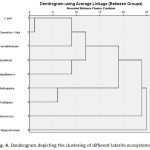 |
|
Dendogram depicting the similarity in species composition between different selected study areas (Fig. 4) showed more similarity between IT park and Chamakkavu followed by Madayippara and Ariyttapara. Madayippara and ariyittapara are open laterite hill top with almost same vegetation, where as in the case of IT park and Chamakkavu both are different in their topography and plant distribution the presence of home gardens around the chamakkav is one the main reason for similarity of butterfly species with the laterite hills of IT park area.
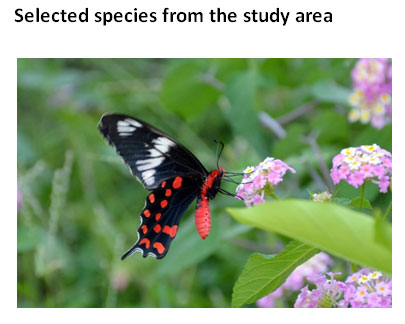
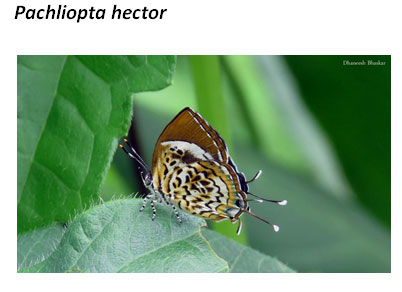
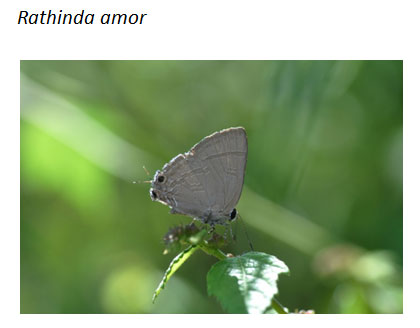
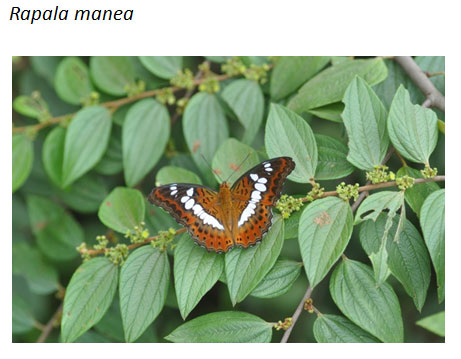
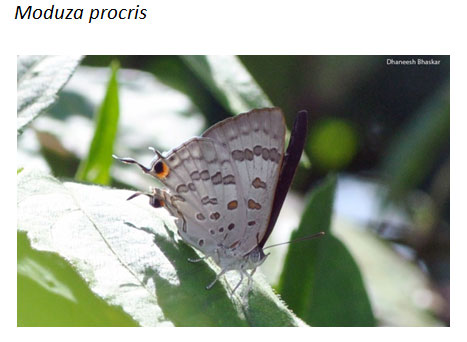
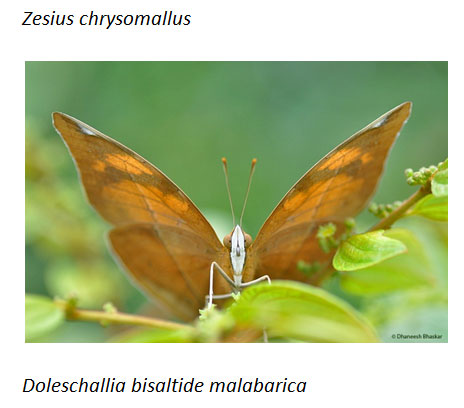
Acknowledgement
The authors are thankful to the Kerala State Council for Science, Technology, and Environment, Government of Kerala for providing financial support. Thanks to Dr.K.V.Sankaran and Dr. P.S .Easa, former Directors of KFRI for their support and encouragement.
Table 1: Butterfly checklist of Laterite ecosystems of Kavvayi river basin, Kerala, India.
|
# |
Scientific name |
Common name |
Status |
A1 |
A2 |
A3 |
A4 |
A5 |
A6 |
A7 |
A8 |
A9 |
|
Family: PAPILIONIDAE |
||||||||||||
|
1 |
Troides minos |
Sahyadri Birdwing |
VC |
+ |
+ |
+ |
+ |
+ |
+ |
+ |
+ |
+ |
|
2 |
Pachliopta aristolochiae |
Common Rose |
VC |
+ |
+ |
- |
+ |
+ |
+ |
- |
+ |
+ |
|
3 |
Pachliopta pandiyana Moore |
Malabar Rose |
C,E |
+ |
- |
+ |
- |
- |
+ |
- |
- |
+ |
|
4 |
Pachliopta hector |
Crimson Rose |
C, SchI |
+ |
+ |
+ |
+ |
+ |
+ |
+ |
+ |
- |
|
5 |
Papilio clytia clytia |
Oriental Common Mime |
VC, Sch I |
+ |
+ |
+ |
+ |
+ |
+ |
+ |
+ |
+ |
|
6 |
Papilio demoleus |
Lime Butterfly |
VC |
+ |
+ |
+ |
+ |
+ |
+ |
+ |
+ |
+ |
|
7 |
Papilio liomedon |
Malabar Banded Swallowtail |
R, E Sch I |
- |
- |
- |
+ |
- |
- |
- |
- |
- |
|
8 |
Papilio dravidarum |
Malabar Raven |
VC, E |
+ |
+ |
- |
+ |
+ |
+ |
+ |
+ |
+ |
|
9 |
Papilio helenus |
Red Helen |
VC |
+ |
+ |
+ |
+ |
+ |
+ |
+ |
+ |
+ |
|
10 |
Papilio polytes |
Common Mormon |
VC |
+ |
+ |
+ |
+ |
+ |
+ |
+ |
+ |
+ |
|
11 |
Papilio polymnestor |
Blue Mormone |
VC |
+ |
+ |
+ |
+ |
+ |
+ |
+ |
+ |
+ |
|
12 |
papilio paris |
Paris Peacock |
VC |
+ |
+ |
+ |
+ |
+ |
+ |
+ |
+ |
+ |
|
13 |
Papilio buddha |
Malabar Banded Peacock |
C |
- |
+ |
- |
+ |
+ |
- |
- |
- |
+ |
|
14 |
Graphium sarpedon |
Common Bluebottle |
VC |
+ |
+ |
+ |
+ |
+ |
+ |
+ |
+ |
+ |
|
15 |
Graphium doson |
Common Jay |
R |
- |
- |
+ |
- |
- |
+ |
- |
+ |
- |
|
16 |
Graphium agamemnon |
Tailed Jay |
VC |
+ |
+ |
+ |
+ |
+ |
+ |
+ |
+ |
+ |
|
Family: PIERIDAE |
||||||||||||
|
17 |
Delias eucharis |
Common Jezebel |
VC |
+ |
+ |
+ |
+ |
+ |
+ |
+ |
+ |
+ |
|
18 |
Prioneris sita |
Painted Sawtooth |
VC |
+ |
+ |
+ |
+ |
+ |
+ |
+ |
+ |
+ |
|
19 |
Leptosia nina |
Psyche |
VC |
+ |
+ |
+ |
+ |
+ |
+ |
+ |
+ |
+ |
|
20 |
Cepora nerissa |
Common Gull |
C, Sch II |
- |
- |
+ |
+ |
+ |
+ |
- |
+ |
- |
|
21 |
Cepora nadina |
Lesser Gull |
R, Sch II |
- |
- |
+ |
- |
- |
- |
- |
- |
- |
|
22 |
Belenois aurota aurota |
Pioneer |
R |
- |
- |
+ |
+ |
- |
- |
- |
- |
- |
|
23 |
Appias lyncida |
Chocolate Albatross |
VC, Sch II |
+ |
+ |
+ |
+ |
+ |
+ |
+ |
+ |
+ |
|
24 |
Appias albina |
Common Albatross |
VC |
+ |
+ |
+ |
+ |
+ |
+ |
+ |
+ |
+ |
|
25 |
Ixias pyrene |
Yellow Orange Tip |
C |
- |
+ |
+ |
- |
- |
+ |
- |
+ |
- |
|
26 |
Hebomoia glaucippe |
Sahyadri Great Orange Tip |
VC |
- |
+ |
+ |
+ |
+ |
- |
+ |
+ |
+ |
|
27 |
Pareronia ceylonica |
Dark Wanderer |
VC, E |
+ |
+ |
+ |
+ |
+ |
+ |
- |
+ |
+ |
|
28 |
Catopsilia pomona |
Lemon Emigrant |
VC |
+ |
+ |
+ |
+ |
+ |
+ |
+ |
+ |
+ |
|
29 |
Catopsilia pyranthe pyranthe |
Mottled Emigrant |
VC |
+ |
+ |
+ |
+ |
+ |
+ |
+ |
+ |
+ |
|
30 |
Eurema brigitta |
Small Grass Yellow |
VC |
+ |
+ |
+ |
+ |
+ |
+ |
- |
+ |
- |
|
31 |
Eurema hecabe |
Common Grass Yellow |
VC |
+ |
+ |
+ |
+ |
+ |
+ |
+ |
+ |
- |
|
32 |
Eurema blanda |
Three-spot Grass Yellow |
VC |
+ |
+ |
+ |
+ |
+ |
+ |
+ |
- |
- |
|
Family: LYCAENIDAE |
||||||||||||
|
33 |
Spalgis epeus |
Apefly |
C |
+ |
- |
- |
+ |
- |
- |
+ |
- |
+ |
|
34 |
Castalius rosimon |
Common Pierrot |
VC, Sch I |
+ |
+ |
- |
+ |
+ |
+ |
+ |
+ |
- |
|
35 |
Caleta decidia decidia |
Angled Pierrot |
VC |
+ |
+ |
- |
+ |
+ |
+ |
+ |
+ |
+ |
|
36 |
Discolampa ethion ethion |
Oriental Banded Blue Pierrot |
R |
- |
- |
- |
+ |
+ |
- |
- |
- |
- |
|
37 |
Acytolepis puspa felderi |
Malabar Common Hedge Blue |
R |
+ |
- |
- |
- |
- |
- |
- |
- |
- |
|
38 |
Neopithecops zalmora |
Quaker |
VC |
+ |
+ |
+ |
+ |
+ |
+ |
+ |
- |
- |
|
39 |
Megisba malaya |
Malyan |
VC |
+ |
+ |
+ |
+ |
+ |
+ |
+ |
+ |
+ |
|
41 |
Euchrysops cnejus |
Gram Blue |
R |
+ |
- |
- |
+ |
+ |
- |
- |
- |
- |
|
41 |
Lampides boeticus |
Pea Blue |
R |
- |
- |
- |
+ |
+ |
- |
- |
- |
- |
|
42 |
Jamides bochus |
Dark Cerulean |
R |
- |
+ |
- |
+ |
+ |
- |
- |
- |
- |
|
43 |
Jamides celeno |
Common Cerulean |
VC |
+ |
+ |
+ |
+ |
+ |
+ |
+ |
+ |
+ |
|
44 |
Prosotas nora |
Common Lineblue |
R |
- |
- |
- |
+ |
- |
- |
- |
- |
- |
|
45 |
Talicada nyseus |
Red pierrot |
VC |
+ |
+ |
+ |
+ |
+ |
+ |
+ |
+ |
+ |
|
46 |
Thaduka multicaudata |
Many-Tailed Oak Blue |
C |
- |
- |
- |
+ |
+ |
- |
+ |
+ |
+ |
|
47 |
Arhopala centaurus pirama |
Tamil Centaur Oakblue |
R |
- |
- |
- |
+ |
+ |
- |
- |
- |
- |
|
48 |
Surendra quercetorum |
Common Acacia Blue |
R |
- |
- |
- |
+ |
- |
- |
- |
+ |
- |
|
49 |
Spindasis vulcanus |
Common Sliver Line |
C |
+ |
- |
- |
+ |
- |
- |
- |
+ |
+ |
|
50 |
Loxura atymnus atymnus |
Sahyadri Yamfly |
VC |
+ |
+ |
+ |
+ |
+ |
+ |
+ |
+ |
+ |
|
51 |
Cheritra freja |
Common Imperial |
R |
- |
- |
- |
+ |
- |
- |
- |
- |
+ |
|
52 |
Rathinda amor |
Monkey Puzzle |
VC |
+ |
+ |
+ |
+ |
+ |
- |
+ |
+ |
+ |
|
53 |
Zesius chrysomallus |
Red spot |
R |
- |
- |
- |
+ |
+ |
- |
- |
- |
- |
|
54 |
Zeltus amasa |
Indian Fluffy Tit |
C |
+ |
+ |
- |
- |
- |
- |
- |
+ |
+ |
|
55 |
Virachola isocrates |
Common Guava Blue |
R |
+ |
- |
+ |
- |
- |
- |
- |
- |
- |
|
56 |
Rapala manea |
Slate Flash |
R |
- |
- |
- |
+ |
+ |
- |
- |
- |
- |
|
57 |
Rapala lankana |
Malabar Flash |
R |
- |
- |
- |
+ |
+ |
- |
- |
- |
- |
|
58 |
Curetis thetis |
Indian Sun Beam |
R |
- |
- |
- |
+ |
+ |
- |
- |
+ |
- |
|
59 |
Curetis siva |
Shiva Sun Beam |
R, E |
- |
+ |
+ |
- |
- |
- |
- |
- |
- |
|
Family: RIODINIDAE |
||||||||||||
|
60 |
Abisara echerius |
Plum Judy |
VC |
+ |
+ |
+ |
+ |
+ |
- |
+ |
+ |
+ |
|
Family: NYMPHALIDAE |
||||||||||||
|
61 |
Danaus chrysippus |
Oriental Plain Tiger |
VC |
+ |
+ |
+ |
+ |
+ |
+ |
+ |
+ |
+ |
|
62 |
Danaus genutia |
Stripped Tiger |
VC |
+ |
+ |
+ |
+ |
+ |
+ |
+ |
+ |
+ |
|
63 |
Tirumala limniace |
Blue Tiger |
VC |
+ |
+ |
+ |
+ |
+ |
+ |
+ |
+ |
+ |
|
64 |
Tirumala septentrionis |
Dark Blue Tiger |
VC |
- |
+ |
+ |
+ |
+ |
+ |
+ |
+ |
+ |
|
65 |
Parantica aglea |
Glassy Blue Tiger |
VC |
+ |
+ |
+ |
+ |
+ |
+ |
+ |
+ |
+ |
|
66 |
Euploea core |
Common Crow |
VC |
+ |
+ |
+ |
+ |
+ |
+ |
+ |
+ |
+ |
|
67 |
Ariadne ariadne |
Angled Castor |
VC |
+ |
+ |
+ |
+ |
+ |
- |
+ |
+ |
+ |
|
68 |
Ariadne merione |
Common Castor |
VC |
+ |
+ |
+ |
+ |
+ |
+ |
+ |
- |
+ |
|
69 |
Cupha erymanthis |
Sahyadri Rustic |
VC |
+ |
+ |
+ |
+ |
+ |
+ |
+ |
+ |
+ |
|
70 |
Phalanta phalantha |
Common Leopard |
VC |
+ |
+ |
+ |
+ |
+ |
+ |
+ |
+ |
+ |
|
71 |
Cirrochroa thais |
Tamil Yeoman |
VC, E |
+ |
+ |
+ |
+ |
+ |
+ |
+ |
+ |
+ |
|
72 |
Vindula erota |
Sahyadri Cruiser |
VC |
+ |
+ |
+ |
+ |
+ |
+ |
- |
+ |
+ |
|
73 |
Junonia hierta |
Oriental Yellow Pansy |
VC |
+ |
+ |
+ |
+ |
+ |
+ |
+ |
+ |
+ |
|
74 |
Junonia orithya |
Blue Pansy |
VC |
+ |
+ |
+ |
+ |
+ |
- |
+ |
+ |
+ |
|
75 |
Junonia lemonias |
Lemon Pansy |
VC |
+ |
+ |
+ |
+ |
+ |
+ |
+ |
+ |
+ |
|
76 |
Junonia almana |
Oriental Peacock Pansy |
VC |
+ |
+ |
+ |
+ |
+ |
+ |
+ |
+ |
+ |
|
77 |
Junonia atlites |
Oriental Grey Pansy |
VC |
+ |
+ |
+ |
+ |
+ |
+ |
+ |
+ |
+ |
|
78 |
Junonia iphita |
Oriental Chocolate Pansy |
VC |
+ |
+ |
+ |
+ |
+ |
+ |
+ |
+ |
+ |
|
79 |
Kaniska canace |
Sahyadri Blue Admiral |
R |
- |
+ |
+ |
- |
- |
- |
- |
- |
- |
|
80 |
Hypolimnas misippus |
Danaid Eggfly |
VC, Sch I |
+ |
+ |
+ |
+ |
+ |
+ |
- |
+ |
+ |
|
81 |
Hypolimnas bolina |
Great Eggfly |
VC |
+ |
+ |
+ |
+ |
+ |
+ |
- |
+ |
- |
|
82 |
Kallima horsfieldi |
Sahyadri Blue oakleaf |
C, E |
- |
+ |
+ |
- |
- |
+ |
- |
+ |
+ |
|
83 |
Doleschallia bisaltide malabarica |
Malabar Autumn Leaf |
R |
- |
- |
- |
+ |
+ |
- |
- |
- |
- |
|
84 |
Cyrestis thyodamas |
Map Butterfly |
VC |
+ |
+ |
+ |
+ |
+ |
+ |
+ |
+ |
+ |
|
85 |
Neptis jumbah |
Chestnut-Streaked Sailer |
R |
- |
- |
- |
+ |
- |
- |
- |
+ |
+ |
|
86 |
Neptis hylas |
Indian Common Sailor |
VC |
+ |
+ |
+ |
+ |
+ |
+ |
+ |
+ |
+ |
|
87 |
Pantoporia hordonia |
Oriental Common Lascar |
VC |
+ |
+ |
+ |
+ |
+ |
+ |
+ |
+ |
- |
|
88 |
Athyma inara |
Colour Sergeant |
C |
- |
+ |
+ |
- |
- |
+ |
+ |
- |
- |
|
89 |
Athyma ranga |
Blackvein Sergeant |
C |
- |
- |
- |
+ |
+ |
+ |
+ |
- |
- |
|
90 |
Athyma perius |
Common Sergeant |
R |
- |
- |
- |
+ |
- |
- |
- |
- |
- |
|
91 |
Moduza procris |
Sahyadri Commander |
VC |
+ |
+ |
- |
+ |
+ |
+ |
+ |
+ |
+ |
|
92 |
Parthenos sylvia |
Sahyadri Clipper |
VC |
+ |
+ |
+ |
+ |
+ |
+ |
+ |
+ |
+ |
|
93 |
Tanaecia lepidea |
Grey Count |
VC |
+ |
+ |
+ |
+ |
+ |
+ |
+ |
+ |
+ |
|
94 |
Euthalia lubentina |
Gaudy Baron |
R |
- |
- |
- |
+ |
- |
- |
+ |
- |
+ |
|
95 |
Charaxes athamas |
Common Nawab |
C |
+ |
+ |
+ |
- |
- |
- |
+ |
- |
+ |
|
96 |
Charaxes solon |
Pale Black Rajah |
R |
- |
- |
+ |
- |
- |
- |
- |
- |
- |
|
97 |
Acraea terpsicore |
Tawny Coster |
VC |
+ |
+ |
+ |
- |
+ |
+ |
+ |
+ |
+ |
|
98 |
Melanitis leda |
Common Evening Brown |
VC |
+ |
+ |
+ |
- |
+ |
+ |
+ |
+ |
+ |
|
99 |
Melanitis zitenius |
Sahyadri Great Evening Brown |
R |
- |
- |
- |
- |
- |
- |
- |
- |
+ |
|
100 |
Elymnias hypermnestra |
Common Palmfly |
C |
- |
- |
+ |
+ |
- |
+ |
+ |
+ |
- |
|
101 |
Lethe europa |
Dakhan Bamboo Treebrown |
C |
- |
- |
+ |
+ |
- |
+ |
+ |
- |
- |
|
102 |
Lethe rohria |
Dakhan Common Tree Brown |
C |
+ |
+ |
+ |
- |
- |
- |
- |
- |
+ |
|
103 |
Mycalesis perseus |
Common Bushbrown |
C |
+ |
+ |
+ |
+ |
+ |
- |
- |
+ |
- |
|
104 |
Mycalesis mineus |
Dark-Brand Bushbrown |
R |
- |
+ |
+ |
+ |
- |
- |
- |
- |
- |
|
105 |
Mycalesis junonia |
Malabar Glad-eye-Bushbrown |
VC, E |
+ |
+ |
+ |
+ |
+ |
+ |
+ |
+ |
+ |
|
106 |
Orsotriaena medus |
Sahyadri Medus Brown |
VC |
+ |
+ |
+ |
+ |
+ |
+ |
+ |
+ |
+ |
|
107 |
Ypthima baldus |
Sahyadri Common Fivering |
VC |
+ |
+ |
+ |
+ |
+ |
+ |
+ |
+ |
+ |
|
108 |
Ypthima huebneri |
Common Fourring |
VC |
+ |
+ |
+ |
+ |
+ |
+ |
+ |
- |
+ |
|
Family: HESPERIIDAE |
||||||||||||
|
109 |
Bibasis sena |
Orange-tail Awl |
R |
- |
- |
+ |
+ |
+ |
- |
- |
- |
- |
|
110 |
Choaspes benjaminii |
Indian Awlking |
R |
- |
- |
+ |
- |
- |
- |
- |
- |
- |
|
111 |
Hasora chromus |
Common Banded Awl |
C |
+ |
- |
- |
+ |
+ |
+ |
- |
- |
- |
|
112 |
Hasora taminatus |
White-Banded Awl |
R |
- |
- |
+ |
- |
- |
- |
- |
- |
+ |
|
113 |
Hasora badra |
Common Awl |
R |
- |
- |
+ |
- |
- |
- |
- |
- |
- |
|
114 |
Badamia exclamationis |
Brown Awl |
R |
- |
- |
- |
+ |
- |
- |
- |
- |
+ |
|
115 |
Celaenorrhinus ambareesa |
Dakhan Spotted Flat |
R |
- |
- |
+ |
+ |
- |
- |
- |
- |
- |
|
116 |
Tagiades gana silvia |
Snuffused Snow Flat |
VC |
+ |
+ |
+ |
+ |
+ |
+ |
+ |
+ |
+ |
|
117 |
Gerosis bhagava |
Common Yellow-breasted Flat |
R |
- |
- |
- |
+ |
+ |
- |
- |
- |
- |
|
118 |
Tagiades japetus |
Common Snow Flat |
VC |
- |
+ |
+ |
- |
+ |
+ |
+ |
+ |
+ |
|
119 |
Tagiades litigiosa |
Water Snow Flat |
VC |
- |
+ |
+ |
+ |
+ |
+ |
+ |
+ |
+ |
|
120 |
Sarangesa dasahara |
Common Small Flat |
VC |
+ |
+ |
+ |
+ |
+ |
- |
+ |
+ |
+ |
|
121 |
Sarangesa purendra pandra |
Spotted small Flat |
R |
- |
- |
- |
+ |
- |
- |
- |
- |
- |
|
122 |
Pseudocoladenia dan |
Fulvious Pied Flat |
VC |
+ |
+ |
+ |
+ |
+ |
+ |
+ |
+ |
- |
|
123 |
Coladenia indrani indra |
Tricolor Pied Flat |
VC |
+ |
+ |
+ |
+ |
+ |
+ |
+ |
+ |
+ |
|
124 |
Iambrix salsala |
Chestnut Bob |
VC |
+ |
+ |
+ |
+ |
+ |
+ |
+ |
+ |
+ |
|
125 |
Notocrypta curvifascia |
Restricted Demon |
VC |
+ |
+ |
+ |
+ |
+ |
+ |
+ |
- |
- |
|
126 |
Matapa aria |
Common Redeye |
R |
- |
- |
+ |
- |
- |
- |
- |
- |
+ |
|
127 |
Borbo cinnara |
Rice Swift |
VC |
+ |
+ |
+ |
+ |
- |
- |
+ |
+ |
+ |
|
128 |
Aeromachus pygmaeus |
Pygmy scrub Hopper |
VC |
+ |
+ |
+ |
- |
- |
- |
+ |
- |
+ |
|
129 |
Ampittia dioscorides |
Bush Hopper |
R |
- |
- |
+ |
+ |
+ |
- |
- |
- |
- |
|
130 |
Psolos fuligo |
Coon |
VC |
+ |
+ |
+ |
+ |
+ |
+ |
+ |
+ |
+ |
|
131 |
Notocrypta paralysos |
Common Banded Demon |
R |
- |
- |
+ |
- |
- |
- |
- |
+ |
+ |
|
132 |
Udaspes folus |
Grass Demon |
VC |
+ |
+ |
+ |
+ |
+ |
- |
+ |
+ |
- |
|
133 |
Suastus gremius |
Indian Palm Bob |
C |
- |
- |
+ |
+ |
+ |
- |
+ |
- |
- |
|
134 |
Gangara thyrsis |
Giant Redeye |
R |
- |
- |
- |
+ |
+ |
- |
- |
- |
- |
|
135 |
Telicota bambusae |
Dark Palm Dart |
R |
+ |
- |
- |
- |
- |
- |
- |
+ |
+ |
|
136 |
Oriens concinna |
Tamil Dartlet |
C, E |
+ |
+ |
+ |
+ |
- |
- |
+ |
+ |
- |
|
137 |
Oriens goloides |
Smaller Dartlet |
R |
+ |
+ |
+ |
- |
- |
- |
- |
- |
- |
|
138 |
Taractrocera maevius |
Oriental Grass Dart |
R |
- |
- |
- |
+ |
+ |
- |
- |
- |
- |
|
139 |
Pelopidas mathias |
Dakhan Small Branded Swift |
R |
+ |
+ |
- |
+ |
- |
- |
- |
- |
- |
|
140 |
Erionota thrax |
Palm Redeye |
R |
- |
- |
- |
+ |
- |
- |
- |
- |
+ |
A1 IT park, A2 Chamakkavu, A3 Riparian Ecosystem, A4 Madayippara, A5 Ariyittapara, A6Edayilakkadu kavu, A7 Vannathikkanam, A8 Mappittasserry Kavu, A9 Vattappoyil kanam. VC very common, C common, R rare, E endemic to Western Ghats, Sch I, Sch II,Sch IV: Species protected under schedule I, Schedule II and Schedule IV of Indian Wildlife Protection Act of 1972). + and – are used to represent the presence and absence of butterflies.
References
- Sreejith, K. A., Prashob, P., Sreekumar, V. B., and Prejith, M. P. Microhabitat diversity in a lateritic hillock of northern Kerala, India. Vegetos. 29:3. doi:10.4172/2229-4473.1000145 (2016)
- Vidya, R. A. Butterflying in namdapha. Hornbill1996 (4). PP. 4-6.In: Wilson, EO (ed.) The little things that run the world (the importance and conservation of invertebrates). Conservation Biology: 1: 344-346 (1996)
- Kakati, M. Diversity, Distribution & Ecology of Nymphalidae Butterflies in Rani- Garbhanga reserve forest, Kamrup, Assam. hD. Thesis. Submitted to Gauhati University, 172pp (2006)
- Laesen, T.B. The butterflies of the Nilgiri mountains of the southern India (Lepidoptera:Rhopalocera). Journal of the Bombay Natural History Society 84(1):26-43 (1988)
- Kocher, S.D., and Williams, E.H. The diversity and abundance of North American butterflies vary with habitat disturbance and geography. Journal of Biogeography 27: 785-794 (2000)
CrossRef - Sawchick, J., Dufrene, M., and Lebrun, Ph. Distribution patterns and indicator species of butterfly assemblages of wet meadows in southern Belgium. Belgian Journal of Zoology 135(1): 43-52 (2005)
- Kunte, K. Seasonal patterns in butterfly abundance and species diversity in four tropical habitats in Northern western Ghats. Journal of Bioscience 22(5): 593-603 (1997)
CrossRef - Battist, A. Phytophagous insect in the energy flow of an artificial stand of Pinus nigra Arnold in northern Italy. Redia, 71(1): 139-160 (1988)
- Tiple, A.D., Deshmukh, V.P., and Dennis, R.L.H. Factors influencing nectar plant resource visits by butterflies on a university campus: implications for conservation. Nota Lepidopteralogica 28: 213–224 (2006)
- Palot, M.J., Balakrishnan, V.C., and Kalesh, S. An updated checklist of butterflies of Kerala, with their Malayalam names. Malabar Trogon 9(3): 22–29 (2012)
- Mathew, G. and Rahmathulla, V.K. Studies on Butterflies of Silent Valley National Park, Kerala, India, Entomon, 18: 185–192 (1993) http://silentvalley.gov.in/Ebook/research%20(23).pdf
- Sudheendrakumar, V.V., Binoy, C.F., Suresh, P.V., and Mathew, G. Habitat associations of butterflies in the Parambikulam Wildlife Sanctuary, Kerala, India. Journal of the Bombay Natural History Society, 97: 193–201 (2000)
- Shamsudheen, R. S. M., and Mathew, Diversity of Butterflies in Shendurny Wildlife Sanctuary, Kerala, India. World Journal of Zoology 5 (4): 324-329 (2010) http://www.idosi.org/wjz/wjz5(4)10/19.pdf
- Mathew, G., Shamsudeen, R.S.M., and Chandran, R. Insect fauna of Peechi Vazhani Wildlife Sanctuary, Kerala, India, Zooo’s Print Journal 20(8): 1955–1960 (2005) http://www.zoosprint.org/ZooPrintJournal/2005/August/1955-1960.pdf
CrossRef - Mathew, G., Shamsudeen, R.S.M., and Brijesh, C.M. Insect fauna of Neyyar Wildlife Sanctuary, Kerala, India. Zoos’ Print Journal, 22(12): 2930–2933 (2007) http://www.zoosprint.org/ZooPrintJournal/2007/December/2930-2933.pdf
- Tiple, A.D. Butterfly species diversity, relative abundance and status in Tropical Forest Research Institute, Jabalpur, Madhya Pradesh, central India. Journal of Threatened Taxa 4(7): 2713–2717 (2012)
CrossRef - Gaude, K. and Janarthanam M.K. The butterfly (Insecta: Lepidoptera) diversity of four sacred groves of Goa, India. Journal of Threatened Taxa 7(12): 7927–7932 (2015) http://dx.doi.org/10.11609/JoTT.o4228.7927-32.
CrossRef - Kunte, K. Butterfly Diversity of Pune City along the Human Impact Gradient. Journal of Ecological Society 13/14: 40-45 (2001)http://www.biodiversitylab.org/sites/default/files/images/website/KuntePuneButterflies01.pdf
- Aneesh, K.S., Adarsh C.K. and Nameer P.O. Butterflies of Kerala Agricultural University (KAU) campus, Thrissur, Kerala, India. Journal of Threatened Taxa 5(9): 4422–4440 (2013) http://dx.doi.org/10.11609/JoTT.o2870.4422-40
CrossRef - Prasad, G., Prathibakumari, P.V., and Lizby, A.M. Butterflies of Kerala University Campus, Thiruvananthapuram, Kerala. 3rd Asian Lepidoptera Conservation Symposium and Training Programme, 25–29 (2010)
- Palot, M. J., and Radhakrishnan, C. Faunal diversity of a laterite hill system at Madayipara, Kannur district, Kerala, India. Records of Zoological Survey of India, Occassional Paper No. 242: 1-98 (2005)
- Prendergast, J. R., Quinn, R. M., Lawton, J. H., Eversham, B. C., and Gibbons, D. W. Rarespecies, the coincidence of diversity hotspots andconservation strategies. Nature 365:335–337 (1993)
CrossRef - Oliver, I. O., and Beattie, A. J. Designing a cost-effective invertebrate survey: a test of methods for rapid assessment of biodiversity. EcologicalApplications 6:594–607 (1996).
CrossRef - Lawton, J. H., Bignell, D. E., Bolton, B., Bloemers, G. F., Eggleton, P., Hammond, P. M., Hodda, M., Holt, R. D., Larsen, T. B., Mawdsley, N. A., Stork, N. E., Srivastava, D. S., and Watt, A. D. Biodiversity inventories, indicator taxa and effects of habitat modification in tropical forest. Nature 391:72–76 (1998)
CrossRef - Perfecto, I., Mas, A., Dietsch, T., and Vandermeer, J. Conservation of biodiversity incoffee agroecosystems: a tri-taxa comparison insouthern Mexico. Biodiversity and Conservation12:1239–1252 (2003)
CrossRef - Kehimkar, I. The Book of Indian Butterflies. Bombay Natural History Society and Oxford University Press, Mumbai: 497pp (2008)
- Kunte, K. Butterflies of Peninsular India. Universities Press (Hyderabad) and Indian Academy of Sciences (Bangalore), 254pp (2000)
- Kunte, K., Roy, P., Kalesh, S., and Kodandaramaiah, U. (eds.) Butterflies of India, v. 2.20. Indian Foundation for Butterflies. (2015) http://www.ifoundbutterflies.org/home. 16/10/2015.







